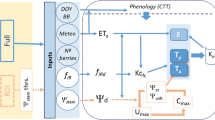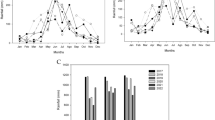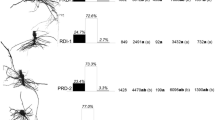Abstract
Cost-benefit analysis was performed to determine the profitability of producing wine grapes under different irrigation regimes. Vines irrigated by regulated deficit irrigation (RDI) and partial root-zone drying (PRD) were compared with vines grown under full irrigation in a typical vineyard in a semiarid environment with scarce water resources (south-eastern Spain) during three consecutive years. Five irrigation treatments were applied. The Control treatment irrigated at 60% of the ETc (Crop evapotranspiration) throughout the orchard cycle. PRD-1 and RDI-1 provided deficit irrigation from fruit set to harvest (irrigated 30% ETc) and post-harvest (45% ETc). PRD-2 and RDI-2 provided deficit irrigation from fruit set to harvest (irrigated 15% ETc) and post-harvest (45% ETc). From an economic point of view, only the Control, PRD-1 and RDI-1 treatments were economically viable since their profitability indicators were positive, although low, especially PRD-1. The more severe deficit irrigated treatments (PRD-2 and RDI-2) were unviable. The most profitable treatment was the Control which had a Net Margin/total cost ratio (NM/C) (representing the overall profitability of the vineyard) of 25.37% compared with the 1.90% of RDI-1 and 0.57% of PRD-1. The threshold price of water indicates that only the Control remains profitable with higher water prices of up to 0.46 € m−3. When the cost-benefit analysis took into account the extra quality achieved in PRD-2 and RDI-2, it indicated that these treatments, which were otherwise economically unviable, achieved high returns (17 and 16%, respectively) and were close to the Control treatment. Thus, a low or moderate bonus that encourages extra berry quality for premium wine production would make deficit irrigation practices profitable. Moreover, the financial indices estimated suggest that in the present situation, and with our soil and climatic conditions, PRD is less economically profitable (higher installation cost, lower NM/C, and threshold price of water) than RDI under the same conditions.


Similar content being viewed by others
References
Ballestero E (2000) Economía de la empresa agraria y alimentaria. Mundi-Prensa, Madrid, p 416 (in Spanish)
Bassoi LH, Dantas BF, Lima JMP, Lima MAC, Leao PCS, Silva DJ, Maia JLT, Souza CR, Silva JAM, Ramos MM (2007) Preliminary results of a long-term experiment about RDI and PRD irrigation strategies in wine grapes in Sao Francisco Valley, Brasil. Acta Hortic 754:275–282
Bindon K, Dry P, Loveys B (2008) Influence of partial rootzone drying on the composition and accumulation of anthocyanins in grape berries (Vitis vinifera cv. Cabernet Sauvignon). Aust J Grape Wine Res 14:91–103
Blanco MI (ed) (1994) Contabilidad de costes: análisis y control. Pirámide, Madrid, p 436 (in Spanish)
Bravdo B, Naor A, Sabih T, Gal Y (2004) The effect of water stress applied alternately to part of the wetting zone along the season (PRD) on wine quality, yield and water relations of red wine grapes. Acta Hortic 664:101–109
Cai X, Rosegrant MW, Ringler C (2003) Physical and economic efficiency of water use in the river basin: implications for efficient water management. Water Resources Res 39(1):1013–1029
Castellarin SD, Matthews MA, Di Gaspero GD, Gambetta GA (2007a) Water deficits accelerate ripening and induce changes in gene expression regulating flavonoid biosynthesis in grape berries. Planta 227:101–112
Castellarin SD, Pfeiffer A, Sivilotti P, Degan M, Peterlunger E, Di Gaspero G (2007b) Transcriptional regulation of anthocyanin biosynthesis in ripening fruits of grapevine under seasonal water deficit. Plant Cell Environ 30:1381–1399
Chaves MM, Santos TP, Souza CR, Ortuño MF, Rodrigues ML, Lopes CM, Maroco JP, Pereira JS (2007) Deficit irrigation in grapevine improves water-use efficiency while controlling vigour and production quality. Ann App Biol 150:237–252
Cifre J, Bota J, Escalona JM, Medrano H, Flexas J (2005) Physiological tools for irrigation scheduling in grapevine (Vitis vinifera L.). An open gate to improve water use efficiency? Agri Ecosys Environ 106:159–170
Clop MM, Cots Ll, Esteban M, Barragán JD (2009) Rentabilidad económica del regadío de los canales de Urgell (Lleida, España). ITEA 105(1):36–48 [In Spanish]
Cos P, De Bruyne T, Hermans N, Apers S, Berghe DV, Vlietinck AJ (2004) Proanthocyanidins in health care: current and new trends. Curr Med Chem 11:1345–1359
Costa JM, Ortuño MF, Chaves MM (2007) Deficit irrigation as strategy to save water: physiology and potential application to horticulture. J Int Plant Biol 49:1421–1434
de Souza CR, Maroco JP, dos Santos T, Rodrigues ML, Lopes C, Pereira JS, Chaves MM (2003) Partial root-zone drying:regulation of stomatal aperture and carbon assimilation in field grown grapevines (Vitis vinifera cv. Moscatel). Funct Plant Biol 30:653–662
de Souza CR, Maroco JP, dos santos T, Rodrigues ML, Lopes C, Pereira JS, Chaves MM (2005a) Control of stomatal aperture and carbon uptake by deficit irrigation in two grapevines cultivars. Agric Ecosyst Environ 106:261–274
de Souza CR, Maroco JP, dos Santos TP, Rodrigues ML, Lopes CM, Pereira JS, Chaves MM (2005b) Impact of deficit irrigation on water use efficiency and carbon isotope composition (d13) of field-grown grapevines under Mediterranean climate. J Exp Bot 56:2163–2172
Dodd IC (2009) Rhizosphere manipulations to maximize crop per drop during deficit irrigation. J Exp Bot 60:2454–2459
dos Santos T, Lopes CM, Rodrigues ML, Souza CR, Maroco JP, Pereira JS, Silva JR, Chaves MM (2003) Partial root-zone drying: effects on growth and fruit quality of field-grown grapevines (Vitis vinifera L.). Funct Plant Biol 30:663–671
Dry PR, Loveys BR, Stoll M, Stewart D, McCarthy MG (2000a) Partial root-zone drying—an update. Aust Grapegrower Winemaker 438a:35–39
Dry PR, Loveys BR, During H (2000b) Partial drying of the root-zone of grape. I. Transient changes in shoot growth and gas exchange. Vitis 39:3–7
Du T, Kang S, Zhang J, Li F, Yan B (2008) Water use efficiency and fruit quality of table grape under alternate partial root-zone drip irrigation. Agri water manag 95:659–668
García-García J (2007) Evaluación económica y eficiencia del agua de riego en frutales de regadío. Consejería de Agricultura y Agua, Murcia, España, p 115, (in Spanish)
García-García J, Romero P, Botía P, García F (2004) Cost-benefit analysis of almond orchard under Regulated Deficit Irrigation (RDI) in SE Spain. Span J Agric Res 2(2):157–165
García-García J, García F, Martínez A (2008) Contabilidad de costes del cultivo de uva de vinificación de secano en la región de Murcia. Vitic y enología prof 115:30–36 [In Spanish]
Glories Y (1984) La coleur des vins rouges. 1. Les équilibres des anthocyanes et des tannins. Connaissance de la Vigne et du Vin 18, 195–217
Gu S, Du G, Zoldoske D, Hakim A, Cochran R, Fugelsang K, Jorgensen G (2004) Effect of irrigation amount on water relations, vegetative growth, yield and fruit composition of Sauvignon blanc grapevines under partial root-zone drying and conventional irrigation in the San Joaquin Valley of California, USA. J Horticul Sci Biotechnol 79:26–33
Intrigliolo DS, Castel JR (2009) Response of Vitis vinifera cv. “Tempranillo” to partial root-zone drying in the field: water relations, growth, yield and fruit and wine quality. Agri water manag 96:282–292
Joscelyne VL, Downey MO, Mazza M, Bastian SEP (2007) Partial shading of Cabernet Sauvignon and Shiraz vines altered wine colour and mouthfeel attributes, but increased exposure had little impact. J Agric Food Chem 55:10888–10896
Keller M (2005) Deficit irrigation and vine mineral nutrition. Am J Enol Vitic 56:267–283
Kriedemann PE, Goodwin I (2003) Regulated deficit irrigation and partial root-zone drying. An overview of principles and applications. Irrigation insights no. 4. Land and Water Australia, p 101
Layard R, Glaister S (1994) Cost-benefit analysis. Cambridge University Press, Cambridge, p 497
Mao JCT (1986) Análisis financiero. Buenos Aires, El Ateneo, p 558 (in Spanish)
MAPA (Ministerio de Agricultura, Pesca y Alimentación) (1995) ORDEN de 10 de noviembre de 1995 por la que se aprueba el Reglamento de la Denominación de Origen Jumilla y de su Consejo Regulador. Available in: http://www.vinosdejumilla.org/crdoj-esp/ReglamentoBOE1995.pdf (in Spanish)
MAPA (1999) Análisis de la economía de los sistemas de producción. Resultados técnico-económicos de explotaciones hortofrutícolas de la Comunidad Valenciana en 1998. Subsecretaría de Agricultura, Pesca y Alimentación. MAPA, Madrid, p 165, (in Spanish)
Marsal J, Mata M, Del Campo J, Arbones A, Vallverdú X, Girona J, Olivo N (2008) Evaluation of partial root-zone drying for potential field use as a deficit irrigation technique in commercial vineyards according to two different pipeline layouts. Irr Sci 26:347–356
McCarthy MG, Loveys BR, Dry PR, Stoll M (2002) Regulated deficit irrigation and partial root zone drying as irrigation management techniques for grapevines. In: Deficit irrigation practices, FAO Water Reports No 22. FAO, Rome, Italy, pp 79–87
Millán A (1988) Rentabilidad del agua en los cultivos más representativos en la Cuenca del Segura. Murcia: Consejería de Agricultura, Ganadería y Pesca, p 93 (in Spanish)
Mishan EJ (1982) Cost-benefit analysis. George Allen & Onwin, London, p 447
Pudney S, McCarthy MG (2004) Water use efficiency of field-grown chardonnay grapevines subjected to partial root-zone drying and deficit irrigation. Acta Hort 664:567–573
Sadras VO (2009) Does partial root-zone drying improve irrigation water productivity in the field? A meta-analysis. Irr Sci 27:183–190
Stoll M, Loveys B, Dry P (2000) Hormonal changes induced by partial root-zone drying of irrigated grapevine. J Exp Bot 51:1627–1634
Wample RL, Smithyman R (2002) Regulated deficit irrigation as a water management strategy in Vitis vinifera production. In: Deficit irrigation practices, FAO Water Reports No 22. FAO, Rome, Italy, pp 89–100
Acknowledgments
This work was financed by the Instituto Nacional de Investigación y Tecnología Agraria y Alimentaria (INIA), Subprograma Nacional de Recursos y Tecnologías Agrarias through the Project RTA2005-00103-00-00 and with the collaboration of The Fondo Social Europeo. Pascual Romero-Azorin gratefully acknowledges a doctoral contract in INIA-CCAA system supplied by the Instituto Nacional de Investigación y Tecnología Agraria y Alimentaria (INIA) co-financed with European Social Fund. We would like to thank Atanasio Molina Molina and Aniceto Turpin Bermejo for his cooperation in the vineyard management and Juan Jose García Sánchez, Jose María Rodriguez de Vera-Beltrí and Jose Ignacio Fernández-Fernández for their field assistance and support with the lab analysis. We also thank Michael Thomlinson for assistance with the manuscript preparation.
Author information
Authors and Affiliations
Corresponding author
Additional information
Communicated by I. Dodd.
Rights and permissions
About this article
Cite this article
García García, J., Martínez-Cutillas, A. & Romero, P. Financial analysis of wine grape production using regulated deficit irrigation and partial-root zone drying strategies. Irrig Sci 30, 179–188 (2012). https://doi.org/10.1007/s00271-011-0274-4
Received:
Accepted:
Published:
Issue Date:
DOI: https://doi.org/10.1007/s00271-011-0274-4




